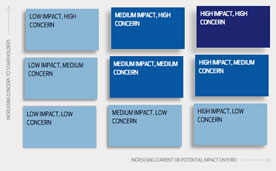Sustainability Report 2013/14
Our Blueprint for Sustainability
Materiality Analysis
Ford generally updates its materiality analysis every other year. We updated the materiality analysis most recently in 2012 and early 2013, adding key inputs, replacing outdated inputs and gathering feedback from internal experts. A Ceres Stakeholder Committee reviewed the analysis in early 2013 and provided feedback. The analysis will be updated again in 2014 to guide development of the 2014/15 Sustainability Report and align the process more closely with the Global Reporting Initiative G4 Reporting Guidelines.
In the most recent analysis, climate change issues remained at the highest level of concern for Ford and external stakeholders. Water and supply chain issues, which had risen to the highest level of importance for both Ford and external stakeholders in the previous materiality analysis, remained highly important.
In addition, some new issues emerged, some dropped out and others were recast or reorganized. Significant changes from previous analyses included the following:
- Financial issues had been at the highest level of importance to Ford and external stakeholders for three materiality analyses (spanning six years). In the 2012/13 analysis, for the first time since 2006, financial issues dropped to the mid level of concern for non-Ford stakeholders, moving them from the “top right” box of our materiality matrix to the “middle right” box. This is likely a reflection of Ford’s strong and consistent improvements in financial performance. Nonetheless, financial health remains a critical issue to Ford and a central focus of our overall strategy and everyday activities. Therefore, we continue to report on it as a highly material issue.
- The governance issue of Ford’s strategy for addressing human rights in our own operations and throughout our supply chain increased to the highest level of priority for non-Ford stakeholders. This was due to increased importance of this issue to communities, investors and customers. The issue was already at the highest level of concern for Ford, but the change moved the issue to the “upper right” box of the material issues matrix. We already report on governance in detail, including Ford’s approach to human rights, and we will continue to do so based on the increased importance of these issues to external stakeholders.
- Water issues were reorganized to reflect water impacts in three key areas: on local communities, from and on Ford operations, and from Ford’s product design decisions. All three of these issues were of the highest concern to Ford and external stakeholders.
- Vehicle safety moved down in importance to stakeholders to a medium level of concern but remained at the highest level of concern for Ford. This likely reflects a view that automakers, including Ford, are managing vehicle safety issues well.
- Supply chain issues, especially those related to the sustainability of raw materials and the environmental and human rights performance of suppliers, remained at the highest level of importance for Ford and other stakeholders. In the 2012/13 analysis, a new category of supply chain issues was added relating to Ford’s approach to identifying and managing supply chain sustainability risks – including raw materials sustainability – and Ford’s process for promoting, assessing and remediating sustainability performance among suppliers.
- Issues associated with Ford’s sustainability strategy, management and governance also increased to the highest level of importance for non-Ford stakeholders, moving this issue to the “upper right” box on the material issues matrix.
Materiality Matrix
Our interactive materiality matrix categorizes issues according to their concern to stakeholders and their current or potential impact on the company.
© 2014 Ford Motor Company
